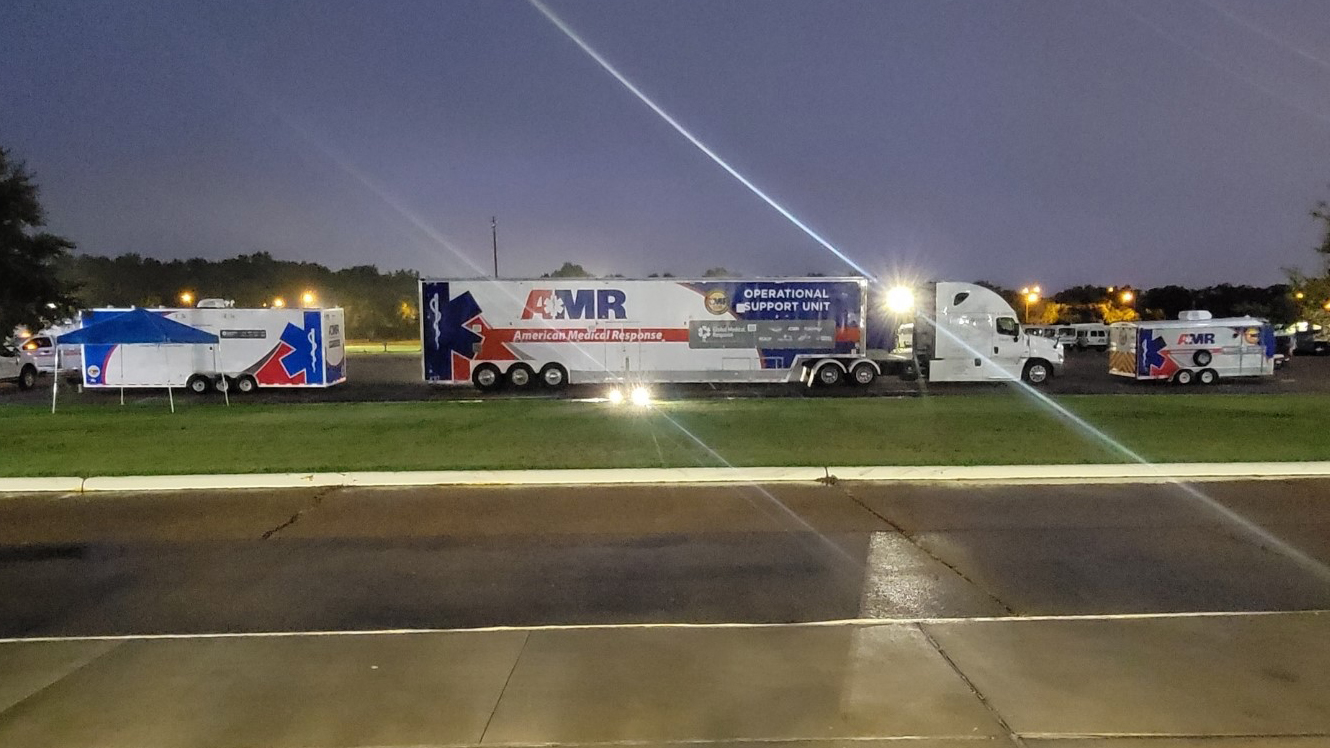Providing Care in the Aftermath of Ida
September 20, 2021
EMT Brandon James goes all out to care for residents affected by Hurricane Ida.
The bustling streets of California's Central Valley look very different from the small towns and parishes of rural Louisiana.
When Hurricane Ida made landfall along the Gulf Coast of the United States as a Category 4 hurricane, American Medical Response (AMR) San Joaquin County EMT and Field Training Officer Brandon James quickly learned the difference between responding to an emergency and providing care in the aftermath of a hurricane and in a region entirely different from his own.
James, along with dozens of other first responders from Global Medical Response (GMR) companies including ambulance, fire, paratransit and air ambulance operations around the country, deployed to the Gulf Coast to help provide hurricane-related emergency medical services prior to and in the aftermath of the storm.
James deployed from San Joaquin County the day that Ida made landfall. He left home intending to help communities and patients in need with no return ticket. Upon his arrival in Jackson, Mississippi, James was assigned to provide aid at a Red Cross evacuation shelter in the small town of Kentwood, Louisiana. James spent several days transporting patients from the shelter in Kentwood to LSU Health Baton Rouge for care. Following his work in Kentwood, James and his partner were reassigned to another Red Cross shelter — this time in the small town of Berwick, Louisiana.
Located along the Atchaflaya River, Berwick has a population of just 5,000 people. So, when Ida made landfall, 80 of those residents sought shelter at the local American Red Cross, where they would meet James.
"Working at the shelter in Berwick was a cool experience," said James. "Many patients didn't have time to grab their prescriptions or insurance cards, so the nurses assigned to the shelter would gather a patient's medical history to determine what medications were needed for their care. From there, members of the Red Cross would call local pharmacies to arrange for emergency refills of their prescriptions. In many cases, though, we had patients who simply couldn't recall what medications they were taking or what medical conditions they had."
Fortunately for those patients, James and his partner have advanced clinical training skills and were ready to provide care and medical transport at a moment's notice.
"We transported several patients to the emergency room for different reasons,” said James. "What's different about providing care to patients in a shelter is that after they were released from the hospital and returned to the shelter, I was able to play an active role in their aftercare. As an EMT, I am usually only with a patient for a short while before handing off care to the hospital, but here, I was able to establish a rapport with my patients and help advocate for them after their hospital stay."
When Hurricane Ida made landfall along the Gulf Coast of the United States as a Category 4 hurricane, American Medical Response (AMR) San Joaquin County EMT and Field Training Officer Brandon James quickly learned the difference between responding to an emergency and providing care in the aftermath of a hurricane and in a region entirely different from his own.
James, along with dozens of other first responders from Global Medical Response (GMR) companies including ambulance, fire, paratransit and air ambulance operations around the country, deployed to the Gulf Coast to help provide hurricane-related emergency medical services prior to and in the aftermath of the storm.
James deployed from San Joaquin County the day that Ida made landfall. He left home intending to help communities and patients in need with no return ticket. Upon his arrival in Jackson, Mississippi, James was assigned to provide aid at a Red Cross evacuation shelter in the small town of Kentwood, Louisiana. James spent several days transporting patients from the shelter in Kentwood to LSU Health Baton Rouge for care. Following his work in Kentwood, James and his partner were reassigned to another Red Cross shelter — this time in the small town of Berwick, Louisiana.
Located along the Atchaflaya River, Berwick has a population of just 5,000 people. So, when Ida made landfall, 80 of those residents sought shelter at the local American Red Cross, where they would meet James.
"Working at the shelter in Berwick was a cool experience," said James. "Many patients didn't have time to grab their prescriptions or insurance cards, so the nurses assigned to the shelter would gather a patient's medical history to determine what medications were needed for their care. From there, members of the Red Cross would call local pharmacies to arrange for emergency refills of their prescriptions. In many cases, though, we had patients who simply couldn't recall what medications they were taking or what medical conditions they had."
Fortunately for those patients, James and his partner have advanced clinical training skills and were ready to provide care and medical transport at a moment's notice.
"We transported several patients to the emergency room for different reasons,” said James. "What's different about providing care to patients in a shelter is that after they were released from the hospital and returned to the shelter, I was able to play an active role in their aftercare. As an EMT, I am usually only with a patient for a short while before handing off care to the hospital, but here, I was able to establish a rapport with my patients and help advocate for them after their hospital stay."



